Black Swallowtail Butterflies North Carolina: Discover!
The Black Swallowtail Butterfly (Papilio polyxenes), common in North Carolina, displays distinctive yellow spots and vivid blue and red markings on its hindwings, with a wingspan of 6.9-8.4 cm.
They inhabit meadows, fields, gardens, and roadsides, thriving in areas rich in nectar. Their lifecycle progresses from eggs on Apiaceae host plants to caterpillars and then adult butterflies post-pupation. Primary threats include birds, spiders, and agricultural chemicals.
Habitat restoration and community initiatives aid their conservation. By selecting host plants like parsley and incorporating nectar-rich flowers, gardeners can support these colorful pollinators. There’s more to discover about their role in local ecosystems.
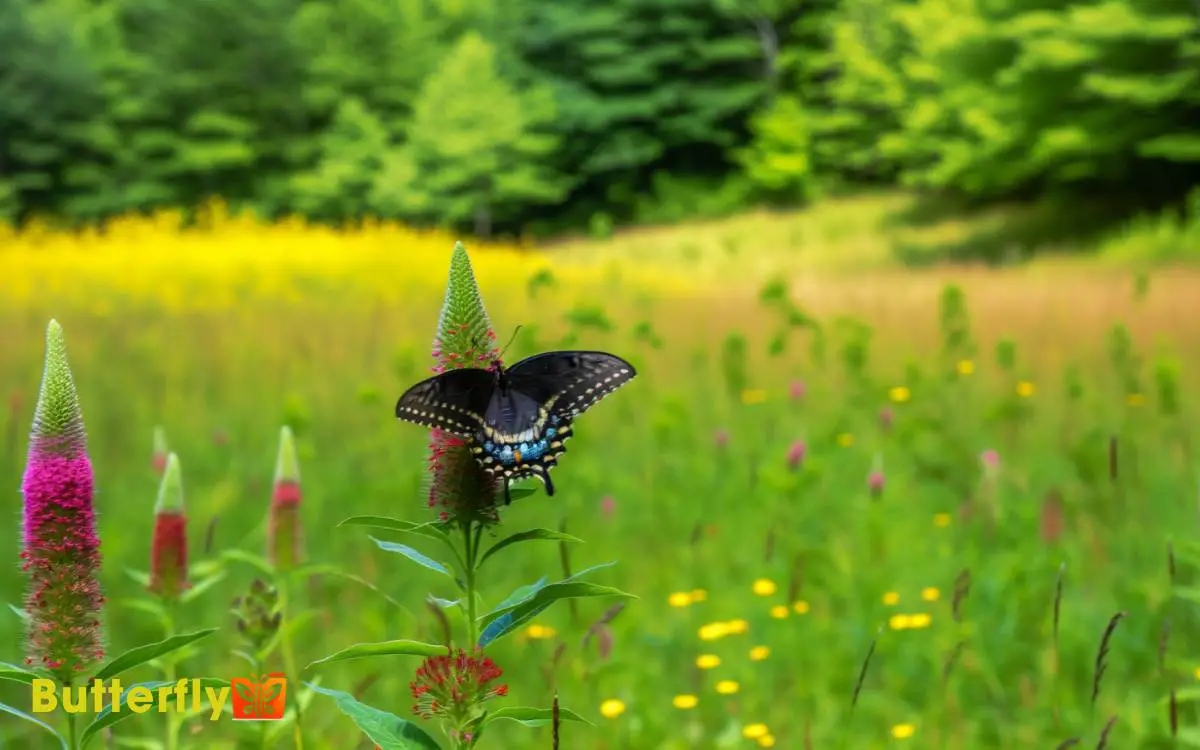
Key Takeaways
Identification
The black swallowtail butterfly, scientifically known as Papilio polyxenes, showcases distinct yellow spots and striking blue and red hindwing markings that aid in its identification.
The upper wings exhibit predominantly black coloring accented by two rows of yellow spots. The hindwings feature a prominent row of blue scales and a singular red-orange spot near the tail, which is characteristic of this species.
Sexual dimorphism is evident; females display more extensive blue areas on the hindwings compared to males. The wingspan ranges from 6.9 to 8.4 centimeters, providing a substantial indicator for identification.
The black swallowtail’s body is mainly black with yellow spots along the sides, complementing its wing pattern and aiding entomologists in distinguishing it from similar species.
Habitat
Black swallowtail butterflies inhabit diverse environments, including meadows, fields, gardens, and roadsides, where host plants such as parsley, dill, and fennel are abundant. These habitats provide the necessary resources for feeding, mating, and laying eggs.
Their preferred environments also include open areas with abundant nectar sources, essential for adult sustenance.
The presence of larval host plants is important, as females lay eggs on these plants, ensuring larvae have immediate access to food upon hatching.
Black swallowtails thrive in regions with mild climates, which North Carolina offers, allowing for multiple generations per year.
They adapt well to both rural and urban settings, displaying remarkable resilience and flexibility in habitat selection, crucial for their ongoing survival and success.
Life Cycle
The life cycle of the Black Swallowtail butterfly (Papilio polyxenes) begins with the egg stage, where females lay small, spherical eggs on host plants.
The eggs hatch into caterpillars, which undergo several growth phases known as instars, each marked by molting.
Egg Stage Overview
While observing the egg stage of the Black Swallowtail butterfly in North Carolina, one notes that females typically lay their eggs on host plants such as dill, parsley, and fennel. These eggs are spherical, measuring approximately 1.5 millimeters in diameter.
Initially, they exhibit a pale yellow hue, gradually darkening as they mature. This transformation indicates embryonic development within the protective chorion. The eggs hatch in about 4 to 9 days, varying with temperature and environmental conditions.
Females strategically place eggs singly to minimize predation risk and competition.
The precise selection of host plants guarantees optimal nutrition for emerging larvae, setting the stage for subsequent life cycle phases. This stage is essential for the butterfly’s survival and future development.
Caterpillar Growth Phases
Upon hatching, the larvae of the Black Swallowtail butterfly enter the first of five distinct instar phases, each characterized by specific morphological changes and rapid growth.
During the initial instar, the caterpillar is small, dark, and covered in spines. As it progresses through successive instars, it molts, sheds its exoskeleton, and grows larger.
Metamorphosis to Butterfly
After completing the fifth instar, the Black Swallowtail caterpillar attaches itself to a suitable substrate, preparing for its remarkable metamorphosis into a butterfly. It forms a chrysalis, within which profound changes occur.
The caterpillar’s tissues break down and reorganize into adult structures. This stage, recognized as pupation, is a demonstration of nature’s transformative power.
- The caterpillar’s vibrant green body fades, replaced by a hardened, protective casing.
- Enzymatic activity dissolves larval tissues, forming imaginal discs.
- These discs differentiate into the butterfly’s wings, legs, and antennae.
- In about 10-20 days, the adult butterfly emerges, ready to explore its new world.
This transformation symbolizes freedom and renewal, as a humble caterpillar becomes a magnificent butterfly, ready to soar.
Diet
The Black Swallowtail butterfly (Papilio polyxenes) exhibits specific host plant preferences, favoring members of the Apiaceae family such as parsley and fennel for larval nourishment.
Adults primarily source nectar from various flowering plants, including milkweed and thistle, which provide essential energy for survival and reproduction.
Understanding these dietary requirements is vital for conservation and habitat management in North Carolina.
Host Plant Preferences
Black Swallowtail butterflies (Papilio polyxenes) exhibit a strong preference for plants in the Apiaceae family, such as dill, fennel, and parsley, as their primary host plants for oviposition and larval development.
These butterflies meticulously choose these plants due to their high nutritional value and chemical defenses, which offer protection against predators. The caterpillars, in turn, are equipped with specialized chemoreceptors to identify these specific plants.
The choice of host plants is vital for:
- Ensuring larval survival by providing essential nutrients.
- Deterring predators through toxic compounds.
- Promoting rapid growth and successful metamorphosis.
- Sustaining population levels in their natural habitat.
This intricate relationship highlights the importance of conserving native Apiaceae plants to support the flourishing of Black Swallowtail populations.
Nectar Sources
Throughout their adult stage, Papilio polyxenes primarily feed on nectar from a variety of flowering plants, utilizing their proboscis to extract this essential source of energy. This species shows a preference for flowers that offer copious amounts of nectar.
Common nectar sources include milkweed (Asclepias spp.), phlox (Phlox spp.), and clover (Trifolium spp.). These plants provide the necessary carbohydrates for energy and survival.
| Flowering Plant | Scientific Name |
|---|---|
| Milkweed | Asclepias spp. |
| Phlox | Phlox spp. |
| Clover | Trifolium spp. |
In North Carolina, the availability of these nectar sources can vary seasonally, influencing the butterflies’ foraging behavior. Consequently, the presence of diverse nectar-rich plants plays a critical role in supporting the population of Black Swallowtail butterflies.
Seasonal Behavior
Observing the seasonal behavior of Black Swallowtail butterflies in North Carolina reveals distinct patterns in their life cycle and migration.
These butterflies exhibit fascinating adaptations to seasonal changes. In spring, adults emerge from overwintering chrysalides, ready to mate and lay eggs.
- Witnessing their transformation can evoke awe.
- Summer breeding: Multiple generations thrive, filling gardens with their vibrant presence.
- Watching their journey southward invokes a sense of freedom.
- Chrysalis dormancy shows nature’s resilience.
Their life cycle intricately ties to the seasons, ensuring survival and continuity. Each phase, from emergence to migration, highlights their adaptability and the beauty of natural cycles. Such behaviors emphasize the interconnectedness and wonder of nature.
Pollination Role
In their role as pollinators, Papilio polyxenes intricately contribute to the reproductive success of various flowering plants across North Carolina.
These butterflies exhibit a preference for nectar from Apiaceae family members, such as Queen Anne’s lace and fennel.
As they forage, pollen adheres to their legs and proboscis, facilitating cross-pollination. Their activity boosts genetic diversity and ecosystem resilience.
This species’ vibrant wings and agile flight patterns make them efficient at accessing nectar from deep floral structures.
Predators and Threats
Black Swallowtail butterflies, Papilio polyxenes, face numerous predators and threats that greatly impact their survival and reproductive success in North Carolina’s diverse ecosystems. These threats range from natural predators to human-induced challenges.
Birds, spiders, and wasps often prey on both larvae and adult butterflies. Additionally, habitat destruction and pesticide use pose significant risks.
Specific threats include:
- Birds: Many bird species see the butterflies as a food source.
- Spiders: Spiders capture them in intricate webs.
- Wasps: Parasitic wasps lay eggs in caterpillars, consuming them from within.
- Pesticides: Chemicals used in agriculture can be lethal to caterpillars and adults.
Understanding these threats is essential for appreciating the delicate balance required for their survival.
Conservation Efforts
Conservation efforts for the Black Swallowtail butterfly (Papilio polyxenes) in North Carolina include targeted habitat restoration initiatives and active community engagement programs.
These programs focus on reestablishing native plant species essential for the butterfly’s lifecycle and educating the public on the importance of pollinator conservation.
Habitat Restoration Initiatives
Efforts to restore the habitat of the Black Swallowtail butterfly in North Carolina involve reestablishing native plant species essential for their life cycle, such as Queen Anne’s lace and parsley.
Biologists focus on creating environments that support both the larval and adult stages of the butterfly.
Critical initiatives include:
- Planting host plants: Ensuring larvae have a food source.
- Nectar sources: Providing adult butterflies with essential nourishment.
- Pesticide reduction: Minimizing toxic exposure.
- Habitat corridors: Connecting fragmented habitats.
These measures aim to foster sustainable populations of Papilio polyxenes asterius, promoting biodiversity and ecological balance.
Community Engagement Programs
Community engagement programs play an essential role in the conservation of the Black Swallowtail butterfly (Papilio polyxenes asterius) in North Carolina.
These programs involve local residents in habitat restoration, educational workshops, and citizen science initiatives.
They focus on enhancing larval host plants, particularly species of the Apiaceae family, such as parsley and dill, which are important for larval development.
Educational workshops are a key component of these programs, informing residents about the butterfly’s life cycle, threats, and measures for protection.
Citizen science projects also play a significant role by encouraging locals to monitor butterfly populations, contributing valuable data for research.
Gardening Tips
By carefully selecting host plants such as dill, fennel, and parsley, gardeners can create a perfect habitat for the black swallowtail butterflies in North Carolina. These plants support the larval stage of Papilio polyxenes, providing essential nutrients for caterpillars.
Ensuring a sunny garden spot with well-drained soil is vital for these butterflies to thrive. Gardeners should also incorporate nectar-rich flowers like milkweed and coneflower to sustain adult butterflies.
- Vibrant color display: Attracts butterflies and adds beauty.
- Biodiversity boost: Encourages a healthy ecosystem.
- Pollination aid: Enhances crop yield.
- Nature connection: Promotes mindfulness and relaxation.
Fun Facts
Importantly, the black swallowtail butterfly (Papilio polyxenes) exhibits sexual dimorphism, where males and females display distinct differences in wing coloration and patterns.
Males typically have more vibrant yellow spots and a bright blue band near the hindwings, while females show larger, more conspicuous blue areas.
This species belongs to the family Papilionidae, known for their characteristic tail-like extensions on the hindwings. Black swallowtails are also known to mimic the toxic pipevine swallowtail (Battus philenor) as a defensive strategy.
Remarkably, their caterpillars secrete a foul-smelling substance called osmeterium to deter predators.
They’re often found in North Carolina’s gardens, feeding on plants in the Apiaceae family, such as parsley and dill. These butterflies play an important role in pollination, supporting biodiversity.
Conclusion
In the tapestry of North Carolina’s ecosystems, the black swallowtail butterfly is a vibrant thread, weaving a tale of survival and beauty. These striking pollinators thrive in gardens, meadows, and open fields, where they lay their eggs on plants like parsley and dill. As they progress through their life cycle, black swallowtail butterflies display remarkable adaptability, mimicking toxic species to deter predators. Their graceful flight and bold wing patterns make them a cherished sight across North Carolina’s diverse landscapes.
As they dance through gardens, meadows, and fields, their presence whispers the importance of conservation and mindful gardening.
By understanding their life cycle, diet, and the dangers they face, we can guarantee these enchanting creatures continue to grace our landscapes.
Protecting the black swallowtail isn’t just an act of preservation, but a celebration of nature’s intricate artistry.

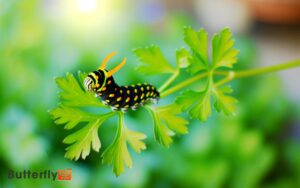
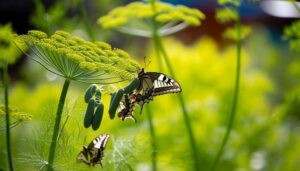
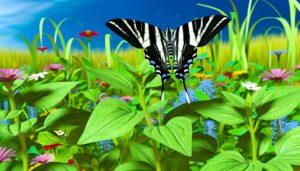
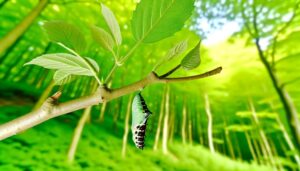


Thank you for your sharing. I am worried that I lack creative ideas. It is your article that makes me full of hope. Thank you. But, I have a question, can you help me?
Can you be more specific about the content of your article? After reading it, I still have some doubts. Hope you can help me.
I don’t think the title of your article matches the content lol. Just kidding, mainly because I had some doubts after reading the article.
Thank you for your sharing. I am worried that I lack creative ideas. It is your article that makes me full of hope. Thank you. But, I have a question, can you help me?
Your point of view caught my eye and was very interesting. Thanks. I have a question for you.
Thank you for your sharing. I am worried that I lack creative ideas. It is your article that makes me full of hope. Thank you. But, I have a question, can you help me?
Can you be more specific about the content of your article? After reading it, I still have some doubts. Hope you can help me.
I don’t think the title of your article matches the content lol. Just kidding, mainly because I had some doubts after reading the article.
I don’t think the title of your article matches the content lol. Just kidding, mainly because I had some doubts after reading the article.
Thanks for sharing. I read many of your blog posts, cool, your blog is very good.
I don’t think the title of your article matches the content lol. Just kidding, mainly because I had some doubts after reading the article.
I don’t think the title of your article matches the content lol. Just kidding, mainly because I had some doubts after reading the article.
Can you be more specific about the content of your article? After reading it, I still have some doubts. Hope you can help me.
Thanks for sharing. I read many of your blog posts, cool, your blog is very good.